Entries from June 10, 2018 - June 16, 2018
Chinese economy slowing, signals mixed
Chinese monetary trends remain worrying but non-monetary leading indicators are giving a more hopeful message for economic prospects. A further slowdown is expected over the remainder of 2018 but weakness may be contained.
The forecasting approach followed here uses non-monetary leading indicators – usefully summarised by the OECD’s composite measures – to cross-check the message from monetary trends. In China’s case, the signals currently conflict, reducing confidence in the forecast.
Monetary trends are unambiguously weak. Annual growth of the official M1 measure fell further to 6.0% in May, the least since 2015, while M2 growth was stable at 8.3%, just above December’s record-low 8.1%. The alternative money measures preferred here were similarly soft, as was the “total social financing” credit measure – see first chart.
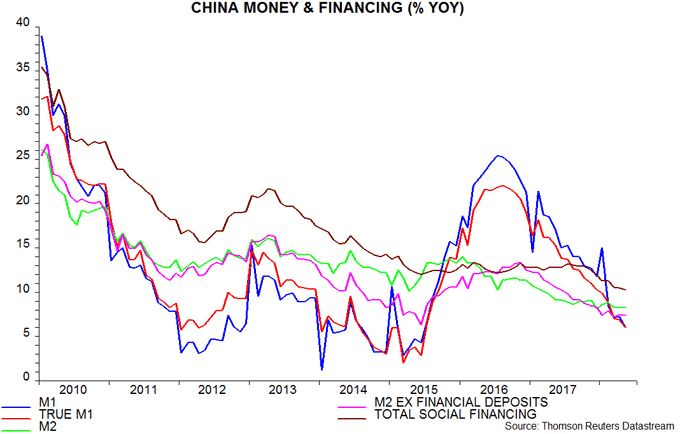
Previous posts suggested that monetary trends would revive in response to an apparent policy reversal towards easing in April, reflected in a sharp fall in term money market rates, although the timing and extent of a recovery were uncertain. The May money and credit data indicate that the policy shift has yet to gain traction, while money rates have recently partially retraced their decline – second chart.
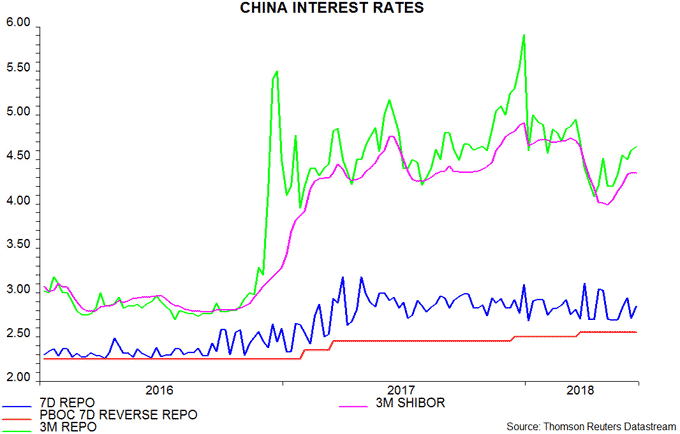
Activity news for May released today appears, on the surface, to be consistent with the negative message from money trends. Annual growth rates of industrial output, retail sales and fixed asset investment fell from April and undershot consensus estimates. Investment growth weakened particularly sharply – third chart.
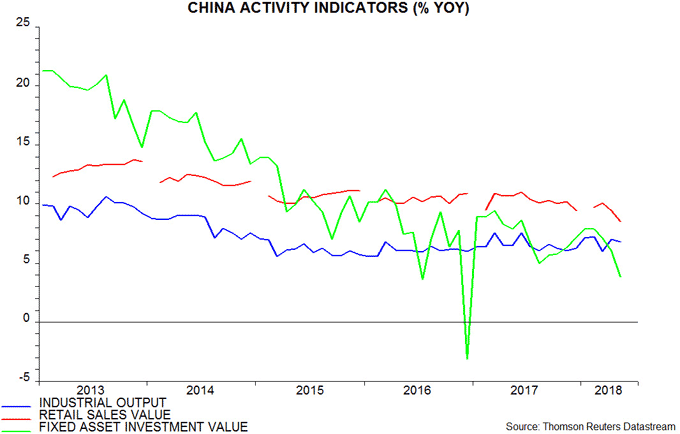
Some details of the reports, however, jar with a negative interpretation. Annual growth of housing sales and starts rose smartly – fourth chart. Steel production was also notably strong. The sharp fall in investment growth, meanwhile, reflected weakness in infrastructure spending, with private capex expansion only slightly lower.

The OECD’s Chinese composite leading indicator, meanwhile, rose for a second month in April, according to data released yesterday – fifth chart. The six components of the indicator are: steel production, motor vehicle production, building completions, production of chemical fertilisers, the export orders balance from the PBoC’s quarterly 5000 enterprise survey and stock market turnover. New data for the first three components released today imply a positive contribution to the indicator reading for May, according to our calculations.
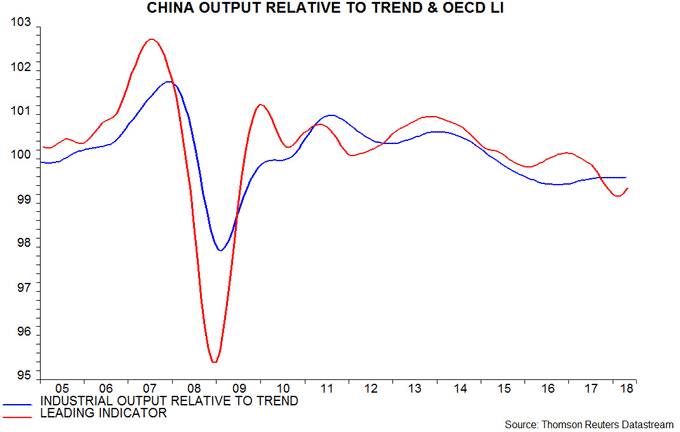
The decline in the leading indicator into February suggests an economic slowdown through late 2018, consistent with the message from monetary trends. Prospects further out are cloudy but a pessimistic bias will be retained here pending a revival in money trends.
Is the MSCI EM index fit for purpose?
The characteristics of the MSCI emerging markets (EM) equities index have changed significantly in recent decades, raising questions about its suitability as a benchmark for EM investing.
The index is now dominated by China, the weight of which rose to 33.2% on 1 June following the addition at end-May of more than 200 A shares with an inclusion factor of 2.5% of their market capitalisation.
China’s weight on 1 June, surprisingly, was not the largest single-country weight in the history of the index – Malaysia’s weight was 33.8% at the inception of the index on 1 January 1988, when there were only 10 country constituents, compared with the current 24 – see first chart.

The largest single-country weight, however, has averaged 20.5% over the 30-year history of the index – well below the current Chinese level. China’s weight, moreover, is likely to increase further – the A share factor is scheduled to rise to 5% at end-August, while it is reasonable to assume full inclusion within 10 years. (The phased inclusion of Korea and Taiwan in the 1990s / 2000s occurred over seven and nine years respectively.) MSCI previously estimated that China would account for about 42% of the index if the A shares were included fully, based on then-prevailing market capitalisations.
The rise of China has resulted in the index providing less regional diversification. At end-1999, Europe, the Middle East and Africa (EMEA) accounted for 31.5% of the index, with Latin America at 28.2%. The weights on 1 June were 13.9% and 10.6% respectively, with Asia up to 75.5%. Asia’s weight could exceed 80% if / when the Chinese A shares are fully included – second chart.

The index has also become less “emerging”. The third chart shows the relative income levels of the EM index (a market capitalisation-weighted average of the constituent countries) and selected countries. Relative income is measured by GDP per capita at purchasing power parity expressed as a percentage of the G7 level. At its inception in 1988, the index represented countries with an average income of about one-third of the G7 level. That proportion has risen to about a half, mainly reflecting the inclusion and rapid growth of Korea and Taiwan. Taiwan’s GDP per capita is now close to the G7 average while Korea’s is within the G7 range. From an economic perspective, neither country should be represented in an EM index.

Investors, arguably, should now allocate to Korea and Taiwan within the developed markets portion of their equity portfolio. Removing them from the EM benchmark, however, would further magnify China’s dominance. There is a case for separating out China, to reflect its size and unique economic characteristics, and to make explicit the allocation decision between China and the rest of EM – in the same way that investors often separate a developed markets portfolio into US and “international” buckets.
Stripping China, Korea and Taiwan from the MSCI EM index would create a benchmark with similar characteristics to the “old” EM index: GDP per capita of the benchmark constituents would be less than 40% of the G7 level – third chart – while the weights of EMEA and Latin America would be much closer to that of Asia – fourth chart.

Are the profits / investment cycles peaking?
Underlying profits growth in the G7 economies cooled in the first quarter of 2018 and is modest by historical standards, casting doubt on expectations of economic strength based on a further pick-up in business investment.
The underlying profits numbers are from the national accounts and refer to the gross domestic operating surplus of corporations (or the closest available measure), which is equivalent to “EBITDA” (i.e. earnings before interest, tax, depreciation and amortisation). The G7 series is a GDP-weighted average of country data. Annual underlying profits growth was 2.8% in the first quarter of 2018, down from 3.7% in the fourth quarter of 2017 and below an average of 3.8% since 1995 – see first chart.
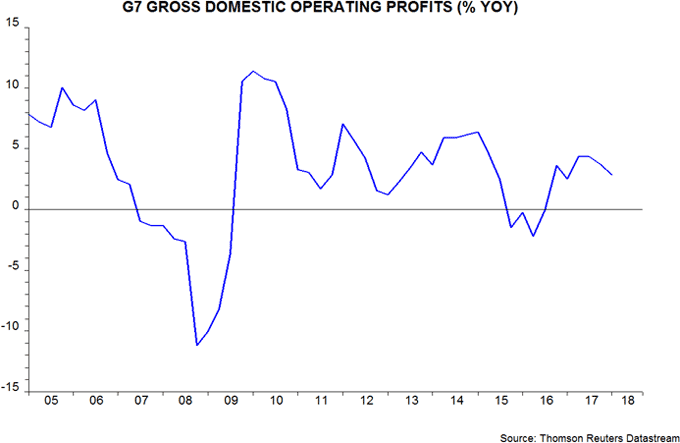
The G7 series has been dragged down by slowdowns in Japan and the UK. Euroland profits growth has also eased, while US growth has been stable but modest – second chart.
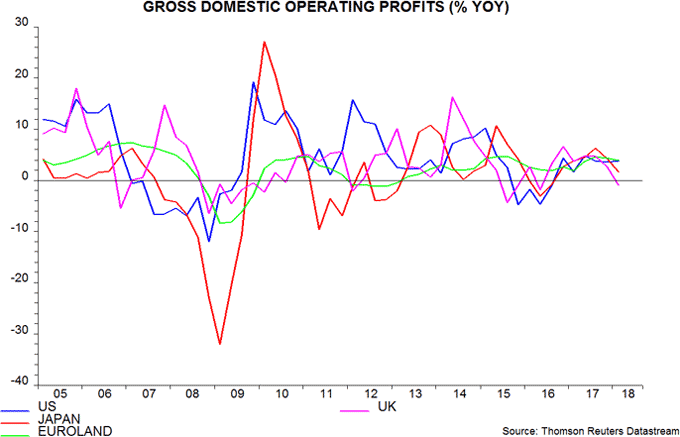
Post-tax US profits, of course, have been boosted by recent tax changes, growing by an annual 8.9% in the first quarter versus 3.9% for the pre-tax measure. Tax cuts, however, are less likely to feed through to business investment if underlying profitability is deteriorating.
Operating margins in the US and several other G7 countries are under threat from rising unit wage cost growth due to stretched labour markets and weak productivity trends. The gap between the US unemployment and job opening rates is an indicator of labour market slack and has displayed a leading relationship with margins historically, with the current message very negative – third chart.

Annual growth of G7 real underlying profits (i.e. current-price profits divided by the GDP deflator) is correlated with, and usually leads, annual business (i.e. non-residential) investment growth. Real profits growth appears to have peaked in the second quarter of 2017, suggesting that investment growth is at or close to a top – fourth chart.
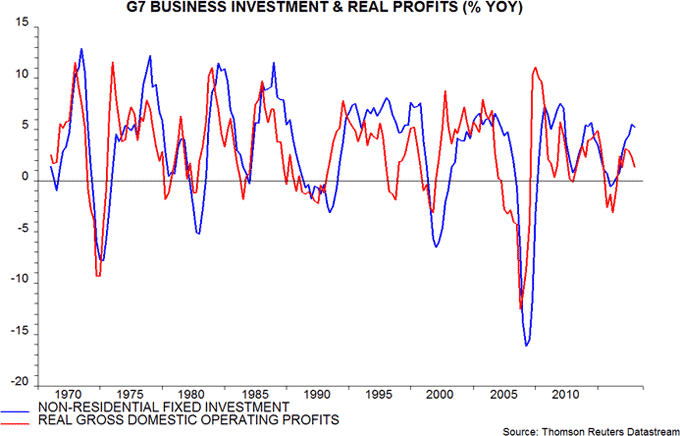
A peak in investment growth would be consistent with the assessment here that the seven- to 11-year Juglar business investment cycle will enter a downswing by 2019. As the fourth chart shows, the annual change in G7 business investment reached lows below -3% in 1975, 1983, 1993, 2002 and 2009. The interval between troughs, that is, ranged from 7.25 to 10.5 years, consistent with the longer-term historical evidence on the length of the Juglar cycle. With the last bottom reached in the second quarter of 2009, another trough is scheduled by the second quarter of 2020 at the latest, implying a downswing starting in 2018-19.

